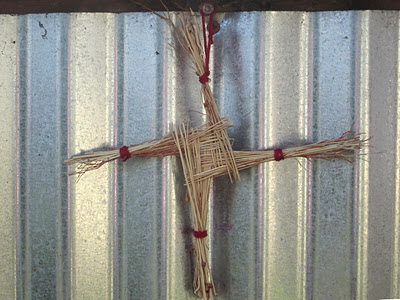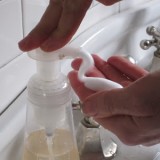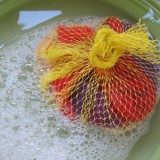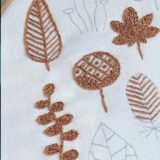Erik’s link to the orange lamp on Saturday reminded me to post this. This is Project #1 in Making It, and we often open our lectures by building one of these, but I realize I’ve never talked about oil lamps here on the blog.
Forgive the somewhat atmospheric photo. What you’re looking at is the simplest thing in the world: an oyster shell filled with olive oil and balanced in a small dish of sand. Three pieces of cotton string are lying in the oil with their ends poking just a little way off the side of the shell. Those are the wicks.
This is a shell lamp. This is perhaps what the first lamp ever looked like. (A Paleo-lamp?) At the very least, this is a fundamental human technology. When you build one, you’re echoing the practices of so many cultures over so much history–from the flat clay oil lamps of Rome to the soapstone lamps of the Inuit to the the ghee-burning temple lamps in India.
Even if you don’t buy all this romance, it’s a good trick to remember next time you’re in a blackout and running out of candles.
One reason I burn little shell lamps like this because I like candlelight, but candles are expensive, especially beeswax candles, which I prefer over petroleum-based candles. Since these lamps use olive oil or any cooking oil for fuel, they’re a great way to us up those rancid or off-tasting oils which tend to clutter the back of our cupboards. I save the stale or otherwise suspicious olive oil from my herb-infused oil experiments for this purpose– oil which I’d have to throw away otherwise. This makes my flame habit essentially free.
The shell lamp FAQ:
- A lamp with a single wick burns approximately 1 tablespoon of oil per hour (burn time varies by wick size and number). You can easily top off the oil as it burns.
- Anything cotton makes for a good wick: a bit of string or a shoe lace or a sliver of cotton rag work great. The wider the wick, the wider the flame. Also, I keep meaning to try a twist of mugwort–I hear that works.
- Want more light? Add more wicks. The shell above has three.
- Yes, you can add a few drops of essential oil for scent.
- Adjust the flame height by lengthening or shortening the wick length. The oil doesn’t get hot, so you can just poke your finger in the shell and push the wicks up or down.
- Don’t use lamp oil, kerosene, etc. as fuel–only cooking oils. Conversely, don’t try to burn cooking oil in other types of oil lamps, like hurricane lamps.
- Stabilize tilting shells either by nesting them in one another or by putting them in little dishes of sand, salt or pebbles. I’m using a couple of oyster shells that I dragged home from an oyster bar right now because I broke my favorite shells, but in terms of restaurant-sourced shells, I prefer big mussel shells because of their depth. Scallop shells work well, too.
- If you don’t have a shell, you can use any shallow vessel. A jar lid works especially well if you dent one edge to make a little “V” for the wick to rest on. Lately I’ve been eyeballing ashtrays in thrift stores, wondering how well the cigarette rests would work as wick rests.
- Like any candle, the open flame can set things on fire, but if you knock one of these over it’s not going to erupt into a conflagration of doom. Olive oil and other cooking oils have high flashpoints. All that will happen is that you’ll stain your favorite tablecloth. The wick will most likely be snuffed out in the spill. If it doesn’t get snuffed out, it will continue burning if it can continue to draw oil from the spill.







And I was getting ready to toss a gallon of old peanut oil…gotta try this
This is so neat. I have never heard of shell lamps before. I cannot wait to try this out.
Thank you so much for sharing!
Do you find that your oil lamps are cat magnets? This is what concerns me. I have a house full of Aladdin oil lamps, a testimony to the uncertainty of our electric supply and the reality of living in a heavily wooded area, but they’re nearly all wall-mounted or hang from the ceiling, specifically to keep curious cats from (even more) mischief. Even if knocking them over won’t start a fire, the thought of cats with oily paws racing through the house (you know, of course, the first stop is anything upholstered) gives me a headache.
I agree with you on the beeswax candles, though. Nothing can beat the smell of the beeswax.
@Donna:
The cats have learned to keep away from flame. Phoebe never had to learn, actually, as she has lots of common sense. Trout, who has no common sense whatsoever, singed his whiskers on a candle and learned his lesson (which is sort of miraculous, considering he rarely learns from his mistakes). I put the lamps away when they’re not being used so that we don’t get the greasy paw effect that you mention.
I have a flame habit as well and this is a revelation. Inspired by this post, I just went on a barrage of research on diy oil lamps and I can’t wait to try out all the variations (especially the orange one). Thank you, thank you, thank you.
I love these oil lamps, this blog, and your books!
Here are a few variations:
1. Periwinkle shells make awesome micro-lamps. Stuff the wick inside the up-turned shell and, using an eye dropper, fill with oil. Light and enjoy in abundance.
2. Build a floating wick holder:
a. Cut a wine cork into disks [ Cork–> O O ]
b. Straighten a paperclip, then kink a small loop at the center to create an eye for the wick. [Straightened paperclip with eye –> —o— ]
c. Poke the ends of the paperclip into the cork disks [ II—o—II ]
d. Thread the wick through the eye of the new float [ II—i—II ]
e. Float and light: ~~~~~~II—i—II~~~~~~~~
Enjoy
I love the shell lamps. On a more practical note, there are lots of pimiento jars around here that are begging to be used. Sanding and spraying the lids, making a hole with nail and hammer, and storing with oil and wicks and matches might be a prudent idea for power outages that we rarely ever have but dread.Everytime I read about any oil lamp, I decide to make one. Now, to look for shells!
Would cotton crochet thread work for a wick?
This is a wonderful post, so romantic looking.
I tried this in our home after reading the project from your book. I figured it was the first project so I had to at least try that one. I did not have any shells but I do have some extra ball canning jars so I reaserched on youtube and played around a bit and made one of my own. Oil in bottom of jar, paper clip tweaked around jar and holding up wick. Worked well. However, my wife and I both noticed a decent amount of black smoke came off of the wick as it burnt. It was not enough to set the fire alarm but I did worry a bit about where it was set as it could get some nasty black stains going on a wall. Any suggestions? Did I do something wrong? Too big of a wick?
Hey Chris,
I’m not such a fan of deeper lamps and lamps that have wicks suspended with paper clips and whatnot. I know some people use them, but I’ve had nothing but problems when I’ve experimented with them. I really like the shell lamps. I think the low flat shape with the wick placed low on the side evolved that way for a reason. Just do a google image search for “greek oil lamp” — for instance– and see what you get.
Thanks for the info. It seems like the depth then might be the issue. You are right when doing the google image search for “greek oil lamp” you get much more flat and shallow shapes like a shell. I will have to try this out instead. Thanks for the feedback.
The fishmonger at WF just gave me some large oyster shells so I can make one of these lamps. Love that briny smell too.
>any100% natural fiber
I’d say plant fiber, rather than natural fiber. Wool and silk probably wouldn’t work.
Asbestos is natural, but not plant-based, and would work brilliantly well (was used in temples for centuries), but I can see why one wouldn’t want to. Glass and basalt fibers aren’t, and they’d work OK. I think there are some rayons that would work, too…plant-based, but not natural.
Right. Fixed. Good catch. Wool would be stinky! For our purposes here and now I’m just going to specify cotton.
what do you think of using peanut oil from deep frying and filtered (I’m sure it will smell of food).
peanut oil would work–but yep, it might smell food-ish. Try it. It doesn’t cost anything!
Pingback: Diyas: oil lamps from India | Root Simple
Try using half of an orange (or any citrus) rind as a base …..
Pingback: A ceramic oil lamp | Root Simple